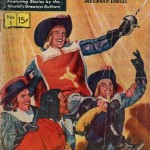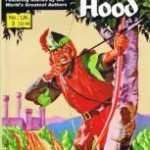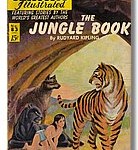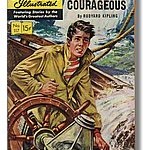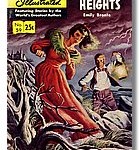My elementary school library was a paradise. I don’t remember much about it, other than that when I was there, I was left alone to do what I like best – read. I don’t remember whether there were other people in the library, but my sense was that I was alone. The librarian is, in my memory, an amorphous shape, watching me kindly without interfering. It was quiet oasis, full of my best friends, books.
In the stacks, in the back left corner of the first row was the pile.
…and dozens more Classics Illustrated comics.
This huge pile of classic comics were my key into a kingdom of literature in which I still maintain a summer home. It was through these brightly colored, “Boy’s Own”-type stories that I was moved to read some of the best – and some of the worst – American and British Literature had to offer.
I devoured these comics. I spent every moment I could in that library and when I had read and re-read every comic in that pile, I turned to the rest of the stacks and started to read the books synopsized in those comics. This was an act whose fruit was born when I was in high school and realized that I was the only one in my class who had heard of, much less already read, everything we covered in Freshman literature. (Except John Knowle’s A Separate Peace which I still am angry and resentful about being made to read.)
Classics Illustrated had it all – characters and plots that had stood the test of time, psychological drama, rollicking adventures, the kind of insight on the human condition I was never going to find in Walter Farley’s horse series.
Crime and Punishment as a comic? Hell yes. Dr. Jekyll and Mr. Hyde? It was *made* to be a comic book. In fact, if Robert Louis Stevenson was alive now, I wager he would be a famous comic writer. (Okay, probably not, but it’s a fun thought.)
In my comic collection I still retain several Classics Illustrated, and while I don’t take them out and read them anymore, I would feel that a piece of my history was gone if I didn’t have them safely tucked away. When I started to seriously collect comics as an adult, these were among the first I added to my collection. Not the holes in the candy-store bought Fantastic Four arc with the reverse-time traveling aliens, (the first story arc I ever really followed…and then immediately regretted it, as it progressively devolved into badly written suck and which I barely remember now, thank you god) but stories that have been seminal for me since those days many years ago.
I suppose that my only regret now is that so few books about or by women were represented. Okay, Scarlet Pimpernel by Baroness Orczy, yes. But, how much of my later intolerance for Jane Austen can be attributed to the fact that there was no Pride and Prejudice in that pile? And yes, I will admit that nothing (NOTHING!) will ever make Wuthering Heights into a good book in my opinion, I now can’t help but wonder if I would have enjoyed a very pretty Heathcliff and Katherine in comic form. These do exist as Classics Illustrated, by the way, they just weren’t in that particular pile in that library, at that moment.
And now, as I sit here thinking over the moment in Ivanhoe when the Unfettered Knight shows up and I said to my 11-year old self, “well, duh, that’s obviously King Richard,” I’m wondering where the hell the Classics Illustrated version of Well of Loneliness is? C’mon folks, Tale of Genji is a story of a pretty boy, his clothes and the women he treats like shit, then Well of Loneliness is perfect for a Classic comic. It’s the story of a woman, her clothes and the woman she treats like shit.
Classics Illustrated aren’t gone, by the way. This isn’t some mopey pining for a lost piece of my childhood. I don’t do that. Classics Illustrated still exists and now include more stories by and about women. They are still an awesome way to introduce a young person to great literature and to comics.
And now I think I’ll contact my old elementary school and ask if I can buy them a collection of the darn things. There’s an eight-year old out there who needs them.

